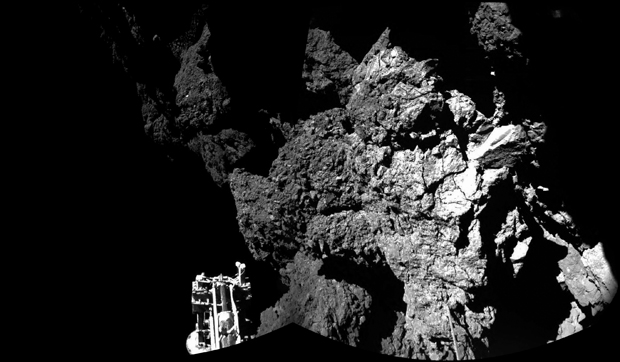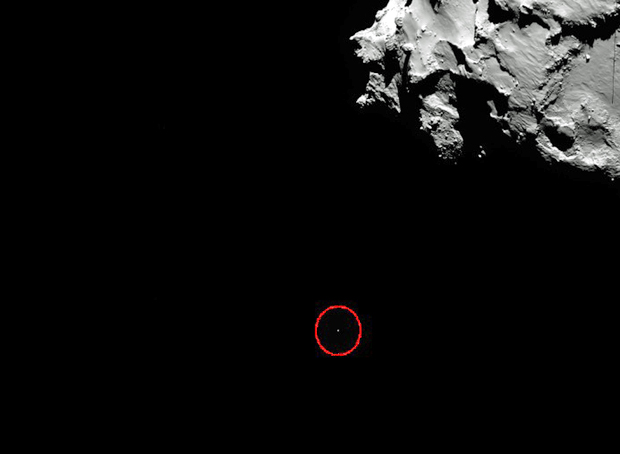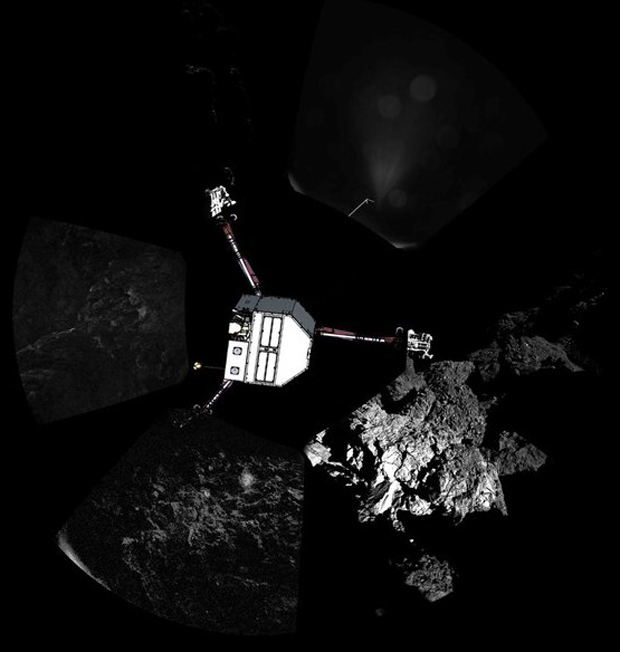Philae comet lander bounced into shadows, raising battery fears
By WILLIAM HARWOOD
CBS News
When the Philae spacecraft landed on Comet 67P/Churyumov-Gerasimenko Wednesday, the anchors needed to hold it down in the feeble gravity failed to fire and the lander bounced back into space, soaring more than a half mile above the nucleus before hitting the ground a second time more than a half mile away, engineers said Thursday.
And then it bounced again, telemetry indicates, finally coming to rest near the base of what appears to be a jagged cliff, with Philae tilted to one side in a jumbled pile of dusty rocks. Two of its three landing legs are in contact with the surface and one extends unsupported, up into space.
Apparently none the worse for its wild ride, Philae is still communicating with its parent spacecraft -- Rosetta -- and it appears to be generally healthy with most of its science instruments operating normally.
But the spacecraft ended up in heavily shadowed terrain -- engineers do not yet know exactly where -- and its solar cells are only receiving an hour and a half of sunlight each day instead of the six or seven hours needed to recharge its batteries for extended operation. If nothing is done to improve its orientation, Philae likely will exhaust its battery and shut down sometime during the next few days.
"The lander from a systems point of view is operating nominally," said Koen Geurts, Philae operations manager with DLR, the German space agency. "What we need to understand now is what does this position mean for us? We're not standing parallel to the surface. We're seeing how we can modify the planned nominal operations to cope with this non-nominal position that we're in."
The spacecraft is equipped with two batteries and solar cells for recharging. The batteries were fully charged when Philae was released from Rosetta Wednesday, with enough power for about 60 hours of normal operation.
In its current location and orientation, "we see that we get less solar power than we planned for at the nominal landing site," Geurts said. "We're receiving about one-and-a-half hours of sunlight with respect to the six or seven that we were aiming (for). This, of course, has an impact on our energy budget and our capabilities to conduct science for an extended period of time."
He did not provide an estimate for how long the Philae might operate in its current orientation, saying only that "we are calculating what this means for the near future. At the moment, I cannot say much. Unfortunately, this is not a situation we were hoping for."
Engineers are assessing a variety of options that might be possible to move Philae or improve its orientation with respect to the sun. Redeploying its landing legs in the comet's feeble gravity, for example, likely would cause the lander to move, but Ulemac said nothing like that would be attempted until engineers get a much better understanding of the possible consequences.
New images downlinked from Philae overnight were assembled into a panorama providing a 360-degree view of the terrain around the lander. Much of it is shadowed with few visible details, but several frames provide sharply focused views of the surface, revealing fractured rocks and dust.
Another instrument aboard the lander that was designed to probe the comet's hidden interior was used to get a sense of where Philae ended up after its bouncing descent. It appears the spacecraft may be near the wall of a huge crater on one end of the comet. Engineers expect to pinpoint the location soon and high-resolution views from Rosetta's OSIRIS camera might have captured a view of Philae in flight, during its initial two-hour bounce.
New OSIRIS images were release Thursday showing Philae's departure from Rosetta and one dramatic shot showing the lander about an hour before touchdown, appearing as a faint speck of light in the black of space with the rugged comet looming to one side.
Philae's improbable landing was a surprise to just about everyone involved in the project.
Because 67P/Churyumov-Gerasimenko's gravity is roughly 100,000 times weaker than Earth's, Philae was equipped with three systems to make sure it didn't bounce off at touchdown.
Each of its three landing legs featured ice screws designed to bore into the crust of the nucleus for extra grip. In addition, two harpoons were designed to fire into the surface while a cold-gas thruster on top of the spacecraft pushed down to counteract the recoil from the harpoons.
But none of the anchors worked, and Philae bounced off the comet after touching down almost dead center in the intended landing zone. Stephan Ulemac, the Philae landing team director, said Wednesday that Philae apparently bounced once and landed twice.
"We landed three times," he said Thursday. "Now we know the first jump (lasted) about two hours, one hour and 50 (minutes). We assume we came in with about 1 meter per second (2.2 mph velocity) then we rebounced with about 38 centimeters per second (0.85 mph velocity)."
Philae reached an altitude of about six tenths of a mile -- more than 3,000 feet if the estimates are correct -- landing again about six-tenths of a mile away. The second bounce, at a rebound velocity of about .07 mph, lasted just seven minutes or so with Philae coming to rest near the base of a cliff of some sort.
"After our first touchdown signal yesterday, we saw immediately that something was not nominal because our system data was indicating the lander was still moving," Geurts said. "And this could only indicate we were not standing on the comet's surface. Fortunately, the comm link between Rosetta and Philae remained intact. We continuously saw the lander kept rotating.
"We observed this for about two hours, and we saw a change in this and we saw the rotation stopped. This was a very good signal because the rotation could only stop by touching the comet again. So for us, this was a clear indication we were at the comet."
But the distance and duration of the first bounce "makes it difficult to find out where we are now," Ulemac said. "We know very well where we touched down the first time. It was a huge leap, then we had another very small jump of about 3 centimeters per second for seven minutes. Now we are in a configuration as you've seen in the images here."
Only instruments that operate passively, without imparting any motion due to mechanical movements or deployments, are currently operating. Philae's drill, for example, designed to penetrate the surface of the nucleus and extract soil samples, remains stowed pending additional analysis.
"This evening, we should re-establish (communications) and then we will upload the newest science sequence we want to operate on the comet," Ulemac said. "Since we do not really know how we are landed, since we are not anchored, somehow just with the weight of the lander, we need to be very careful about activating mechanisms."
The Rosetta spacecraft, meanwhile, continues operating in near flawless fashion, collecting science data and helping with the search for Philae. Unlike the lander, which was never expected to operate more than a few months, Rosetta will fly in tandem with 67P/Churyumov-Gerasimenko for the next year and a half, recording how the comet changes as it nears the sun and then recedes.
About 80 percent of the science expected during the mission will come from Rosetta's instruments with the rest coming from Philae.
Jean-Pierre Bibring, a lead scientist with the Philae project, urged reporters not to over-emphasize the lander's current difficulties.
"What's really impressive is not really the degree of failure that we encountered but the degree of success we had here," he said. "At this point, I think the message is certainly not to say 'well, they are here now, but they should have been elsewhere.' It's amazing where we are, we landed! We analyzed a lot of things already, in 20 hours, it's amazing what we've been doing or what we'll be doing by the end of this day. It's really tremendous.
"We are really at the limit of what humankind could do 20 years ago, and are still capable of doing now. But please do not put the emphasis on the failure of the system. It's gorgeous where we are."
CBS News
When the Philae spacecraft landed on Comet 67P/Churyumov-Gerasimenko Wednesday, the anchors needed to hold it down in the feeble gravity failed to fire and the lander bounced back into space, soaring more than a half mile above the nucleus before hitting the ground a second time more than a half mile away, engineers said Thursday.
And then it bounced again, telemetry indicates, finally coming to rest near the base of what appears to be a jagged cliff, with Philae tilted to one side in a jumbled pile of dusty rocks. Two of its three landing legs are in contact with the surface and one extends unsupported, up into space.
Apparently none the worse for its wild ride, Philae is still communicating with its parent spacecraft -- Rosetta -- and it appears to be generally healthy with most of its science instruments operating normally.
 |
| An image of the surface of Comet 67P/Churyumov-Gerasimenko just beyond the Philae lander, taken after the spacecraft came to a rest two bounces away from its original touchdown point. (Credit: ESA) |
But the spacecraft ended up in heavily shadowed terrain -- engineers do not yet know exactly where -- and its solar cells are only receiving an hour and a half of sunlight each day instead of the six or seven hours needed to recharge its batteries for extended operation. If nothing is done to improve its orientation, Philae likely will exhaust its battery and shut down sometime during the next few days.
"The lander from a systems point of view is operating nominally," said Koen Geurts, Philae operations manager with DLR, the German space agency. "What we need to understand now is what does this position mean for us? We're not standing parallel to the surface. We're seeing how we can modify the planned nominal operations to cope with this non-nominal position that we're in."
The spacecraft is equipped with two batteries and solar cells for recharging. The batteries were fully charged when Philae was released from Rosetta Wednesday, with enough power for about 60 hours of normal operation.
In its current location and orientation, "we see that we get less solar power than we planned for at the nominal landing site," Geurts said. "We're receiving about one-and-a-half hours of sunlight with respect to the six or seven that we were aiming (for). This, of course, has an impact on our energy budget and our capabilities to conduct science for an extended period of time."
He did not provide an estimate for how long the Philae might operate in its current orientation, saying only that "we are calculating what this means for the near future. At the moment, I cannot say much. Unfortunately, this is not a situation we were hoping for."
Engineers are assessing a variety of options that might be possible to move Philae or improve its orientation with respect to the sun. Redeploying its landing legs in the comet's feeble gravity, for example, likely would cause the lander to move, but Ulemac said nothing like that would be attempted until engineers get a much better understanding of the possible consequences.
New images downlinked from Philae overnight were assembled into a panorama providing a 360-degree view of the terrain around the lander. Much of it is shadowed with few visible details, but several frames provide sharply focused views of the surface, revealing fractured rocks and dust.
Another instrument aboard the lander that was designed to probe the comet's hidden interior was used to get a sense of where Philae ended up after its bouncing descent. It appears the spacecraft may be near the wall of a huge crater on one end of the comet. Engineers expect to pinpoint the location soon and high-resolution views from Rosetta's OSIRIS camera might have captured a view of Philae in flight, during its initial two-hour bounce.
New OSIRIS images were release Thursday showing Philae's departure from Rosetta and one dramatic shot showing the lander about an hour before touchdown, appearing as a faint speck of light in the black of space with the rugged comet looming to one side.
 |
| The OSIRIS camera aboard ESA's Rosetta spacecraft captured this image of the Philae lander (circled) about an hour before touchdown on 67P/Churyumov-Gerasimenko. (Credit: ESA) |
Philae's improbable landing was a surprise to just about everyone involved in the project.
Because 67P/Churyumov-Gerasimenko's gravity is roughly 100,000 times weaker than Earth's, Philae was equipped with three systems to make sure it didn't bounce off at touchdown.
Each of its three landing legs featured ice screws designed to bore into the crust of the nucleus for extra grip. In addition, two harpoons were designed to fire into the surface while a cold-gas thruster on top of the spacecraft pushed down to counteract the recoil from the harpoons.
But none of the anchors worked, and Philae bounced off the comet after touching down almost dead center in the intended landing zone. Stephan Ulemac, the Philae landing team director, said Wednesday that Philae apparently bounced once and landed twice.
"We landed three times," he said Thursday. "Now we know the first jump (lasted) about two hours, one hour and 50 (minutes). We assume we came in with about 1 meter per second (2.2 mph velocity) then we rebounced with about 38 centimeters per second (0.85 mph velocity)."
Philae reached an altitude of about six tenths of a mile -- more than 3,000 feet if the estimates are correct -- landing again about six-tenths of a mile away. The second bounce, at a rebound velocity of about .07 mph, lasted just seven minutes or so with Philae coming to rest near the base of a cliff of some sort.
"After our first touchdown signal yesterday, we saw immediately that something was not nominal because our system data was indicating the lander was still moving," Geurts said. "And this could only indicate we were not standing on the comet's surface. Fortunately, the comm link between Rosetta and Philae remained intact. We continuously saw the lander kept rotating.
"We observed this for about two hours, and we saw a change in this and we saw the rotation stopped. This was a very good signal because the rotation could only stop by touching the comet again. So for us, this was a clear indication we were at the comet."
But the distance and duration of the first bounce "makes it difficult to find out where we are now," Ulemac said. "We know very well where we touched down the first time. It was a huge leap, then we had another very small jump of about 3 centimeters per second for seven minutes. Now we are in a configuration as you've seen in the images here."
Only instruments that operate passively, without imparting any motion due to mechanical movements or deployments, are currently operating. Philae's drill, for example, designed to penetrate the surface of the nucleus and extract soil samples, remains stowed pending additional analysis.
"This evening, we should re-establish (communications) and then we will upload the newest science sequence we want to operate on the comet," Ulemac said. "Since we do not really know how we are landed, since we are not anchored, somehow just with the weight of the lander, we need to be very careful about activating mechanisms."
 |
| In this composite, an image of the Philae lander is superimposed on a panorama shot by the spacecraft showing its immediate surroundings. Toward the top of the image is black sky, indicating that side of the lander is tilted up. (Credit: ESA) |
The Rosetta spacecraft, meanwhile, continues operating in near flawless fashion, collecting science data and helping with the search for Philae. Unlike the lander, which was never expected to operate more than a few months, Rosetta will fly in tandem with 67P/Churyumov-Gerasimenko for the next year and a half, recording how the comet changes as it nears the sun and then recedes.
About 80 percent of the science expected during the mission will come from Rosetta's instruments with the rest coming from Philae.
Jean-Pierre Bibring, a lead scientist with the Philae project, urged reporters not to over-emphasize the lander's current difficulties.
"What's really impressive is not really the degree of failure that we encountered but the degree of success we had here," he said. "At this point, I think the message is certainly not to say 'well, they are here now, but they should have been elsewhere.' It's amazing where we are, we landed! We analyzed a lot of things already, in 20 hours, it's amazing what we've been doing or what we'll be doing by the end of this day. It's really tremendous.
"We are really at the limit of what humankind could do 20 years ago, and are still capable of doing now. But please do not put the emphasis on the failure of the system. It's gorgeous where we are."